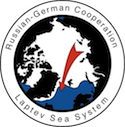 Task 1A
Task 1A
Hydrography and water-mass formation in the Laptev Sea (TRANSDRIFT XXIV, XXV)
Task A will focus on oceanographic processes and water mass formation on the Laptev Sea shelf and provide the major link between previous Russian-German projects within this part-nership and the proposed project. This partnership resulted in some of the most extensive datasets available from anywhere on the Siberian shelves, which broadly improved the scientific knowledge of these regions. Recent publications resulting from the "Transdrift" project particularly emphasized the strong temperature increase on the central Laptev Sea shelf related to early ice breakup and the distribution of the Lena River plume, and hence showed important linkages between the physical environment with implications for sea ice, climate and the ecosystem. The core of this task is built around the central-shelf ocean observatory 1893. This location will provide a hydrographic time series from 2013 to 2018, and provides the necessary details to understand water-mass formation, distribution, and variability on seasonal to interannual time scales. A key extension to the "Transdrift" project will be a thorough analysis of historical hydrographic and biogeochemical datasets that are available at AARI, which may allow for longer-term statistical analyses to be put into a climatic context. Mixing processes are a key for water-mass formation and will be extensively studied with microstructure measurements. These will allow to measure vertical fluxes of heat and freshwater and further quantify fluxes of nutrients across the pycnocline, needed to under-stand the biogeochemical conditions in Work Package 3.
Task A will be based on observations from year-round ocean observatories and detailed hydrographic surveys from two expeditions planned for 2017 and 2018. An additional focus will be on long data records, which will allow putting the detailed findings from both the "Transdrift" project and the proposed project into long-term perspectives. Some major scientific outcomes include a broader understanding of shelf processes, in particular the role of earlier ice reduction for the thermal shelf environment, interannual to decadal temperature and salinity variability on the shelf and associated climate patterns, as well as the role of tides and winds on vertical mixing processes.
Task A will be led by AARI scientists, who will be responsible for data mining and the production of long time series from Russian historical data, and then link these long-term records with the detailed datasets produced in the "Transdrift" project and in the proposed project. AWI scientists will primarily design and analyze the moored observations and carry out microstructure measurements on the central shelf. The GEOMAR team will provide a neodymium- and stable-oxygen-isotope-based assessment on the provenance and the sea-ice-related modification of water masses. The team of Kiel University will determine the particle transport at the shelf break by acoustic and optical backscatter data of the ADCPs (Acoustic Doppler Current Profilers) mounted on the ocean observatories.
Task coordinator |
|
| Mikhail Makhotin | Arctic and Antarctic Research Institute |
Key collaborators |
|
| Dorothea Bauch | GEOMAR Helmholtz Centre for Ocean Research Kiel |
| Stefan Buettner | Christian Albrechts University Kiel |
| Jens Hoelemann | Alfred Wegener Institute Helmholtz Centre for Polar and Marine Research |
| Markus Janout | Alfred Wegener Institute Helmholtz Centre for Polar and Marine Research |
| Stanislav Malinovsky | Arctic and Antarctic Research Institute |
